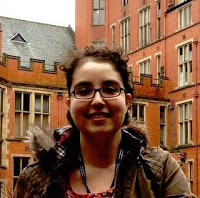How to work in a microbiology lab after an 8.8 earthquake
 Today, I’m hosting Beatriz Gonzalez-Muñoz, with whom I talked on Twitter about working outside of priviliged institutions. Dr. Beatriz Gonzalez-Muñoz is a Chilean scientist with a PhD in Molecular Biology and Biotechnology from the University of Sheffield, UK, where she worked with Professor Simon J Foster studying the bactericidal mechanisms of mammalians against S. aureus. She is a Molecular Biotechnology engineer with a Master in Sciences with a minor in microbiology, which she got under the guidance of Dr Rosalba Lagos from the University of Chile working on the microcin E492 system. She enjoys a good book, scientific conferences in exotic places with nice food, coffee in all of its form (except decaf, that’s just wrong), travelling, museums and corgis. She is currently looking for a job after finishing chemo, so if anybody needs a microbiologist with a PhD, a serious coffee addiction, incredible knowledge about movies and knitter of really long and cozy scarves, please get in contact with Beatriz.
Today, I’m hosting Beatriz Gonzalez-Muñoz, with whom I talked on Twitter about working outside of priviliged institutions. Dr. Beatriz Gonzalez-Muñoz is a Chilean scientist with a PhD in Molecular Biology and Biotechnology from the University of Sheffield, UK, where she worked with Professor Simon J Foster studying the bactericidal mechanisms of mammalians against S. aureus. She is a Molecular Biotechnology engineer with a Master in Sciences with a minor in microbiology, which she got under the guidance of Dr Rosalba Lagos from the University of Chile working on the microcin E492 system. She enjoys a good book, scientific conferences in exotic places with nice food, coffee in all of its form (except decaf, that’s just wrong), travelling, museums and corgis. She is currently looking for a job after finishing chemo, so if anybody needs a microbiologist with a PhD, a serious coffee addiction, incredible knowledge about movies and knitter of really long and cozy scarves, please get in contact with Beatriz.
I’m Beatriz Gonzalez, a Chilean scientist with a PhD in Molecular Biology and Biotechnology from the University of Sheffield, UK. I did my undergrad and my Master in the University of Chile so the Summer of 2010 I decided to stay and work on my thesis, taking advantage of the mostly empty lab. On the night of February 27th I was in Santiago during the 8.8 earthquake that moved Chile for more than three minutes, triggered a tsunami and killed a lot of people.
I have to say that even though Chileans are used to earthquakes and we know what to do (we are trained during elementary, middle and high school, we have plans with our families, know the strongest structural spots in our houses, have emergency kits at home and always lanterns at hand, etc.), this was huge and had a lot of consequences. Phones were not working, streets were cut and bridges fell down, there was a shortage of fuel and, of course, no electricity.
The lab were I worked at the time was a lab where half of the people there worked in microbiology (my half!) and the other half in bioinformatics and structural biology. We didn’t have much money, but everything worked very well because my supervisor was super organized with the money and we had a lab manager that was amazing, responsible, organized and respected/feared by all. Each of us had a specific bench space but we sometimes shared desks. Everything had its place and mostly you could find things were they were supposed to be.
This is why coming into the lab two days after the earthquake was a shock. You could see how the huge unmovable centrifuges moved, how most of the Duran bottles were broken on the floor, everything was out of its place and the ethidium bromide spilled all over. The gas lines were closed until the university was able to confirm they were not broken. And of course, due to the blackout, all the fridges and the freezers were off, coming close to the feared -60ºC that meant that we were going to lose everything.
By this point, most of the postdocs were in the lab and they decided to take charge. I had a jeep so we went to the hardware store and rented an electric generator (using their grants to pay for it!), bought fuel from several gas stations and then went back to the lab. Once everything was connected it was decided that we needed to accumulate good karma and went to all the other labs to ask for another freezer because we were going to receive all of the invaluable samples and cell lines and purified proteins from all the campus. So we ended up with about four freezers connected to that one small generator and samples from at least twelve labs for a week before the electricity was back and the other labs were up and running again.
The gas was another thing, because it took more than two weeks to come back for good. So we had to improvise because deadlines wait for nobody, not even after an earthquake. This meant that we worked using some sort of Molotov bombs: glass bottles filled with ethanol and with a little hole on the lid, though which we put some sort of fabric touching the ethanol. Oh yes, we did tons of electroporations, colony duplication and streaking using this and I feel like it’s important to say that none of the plates had any contamination.
I feel like this prepared me to work in any lab in the world. My project survived an 8.8 earthquake, I got my degree, and I survived all of the aftershocks that came later, even a 6.4 that made us leave the lab in a hurry, but not before I saved the changes on my manuscript and took my computer with me. Nothing can top this.
